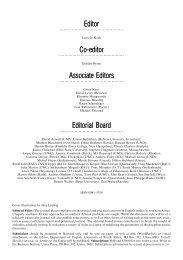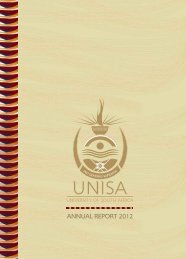pdf: 6.426kb - University of South Africa
pdf: 6.426kb - University of South Africa
pdf: 6.426kb - University of South Africa
Create successful ePaper yourself
Turn your PDF publications into a flip-book with our unique Google optimized e-Paper software.
Upper Palaeolithic beginnings for the use <strong>of</strong> psychotropic<br />
flora. La Barre, while repeatedly stressing the<br />
shamanistic character <strong>of</strong> native religions in the<br />
Americas, notes that the ecstatic nature <strong>of</strong> shamanism<br />
is `culturally programmed for an interest in hallucinogens<br />
and other psychotropic drugs' (Ripinsky-Naxon<br />
1993:44).<br />
Hallucinogenic plants <strong>of</strong> the type used in shamanism<br />
thus require some sort <strong>of</strong> clarification. While by<br />
definition such plants are toxic Ð if we mean by that<br />
something which has a distinct biodynamic effect on<br />
the body Ð this does not mean that such plants are<br />
invariably poisonous, though some are in certain<br />
dosages (e.g. Datura or Sophora secundiflora). As<br />
far as known, none <strong>of</strong> the hallucinogenic plants<br />
utilized in shamanism is addictive. It is also important<br />
that we make the distinction that these plants do not<br />
simply modify moods but are capable <strong>of</strong> producing a<br />
dramatic and <strong>of</strong>ten pr<strong>of</strong>ound change in perception.<br />
Colours are enhanced, spirits may appear, the sacramental<br />
plant appears godlike to the shaman who has<br />
invoked it ceremonially, and perhaps a cosmic bridge<br />
or smoke tunnel appears in the shaman's vision,<br />
allowing him to ascend to the heavens. In every way<br />
the sacred plant is a doorway to a realm that is<br />
awesome and wondrous, and the undertaking is not<br />
one which is taken lightly. To this extent, then, the<br />
ritual use <strong>of</strong> hallucinogenic plants is not recreational<br />
but transformative Ð one undertakes the vision-quest<br />
to `learn' or to `see', not to `escape' into a world <strong>of</strong><br />
`fantasy' (Drury 1982:45).<br />
Psychologists have produced various terms to<br />
describe the substances which produce such radical<br />
shifts in consciousness. Dr Humphry Osmond, an<br />
English psychiatrist, coined the term psychedelic<br />
meaning `mind-revealing' or `mind-manifesting' but<br />
a term preferred by many is psychotomimetic: substances<br />
within this category are capable <strong>of</strong> inducing<br />
temporary psychotic states <strong>of</strong> such intensity that the<br />
`visionary' or `dream' world appears pr<strong>of</strong>oundly real. In<br />
shamanic societies experiences like this are highly<br />
valued. Sacred plants remove the barriers between<br />
humankind and the realm <strong>of</strong> gods and spirits, and<br />
from them one receives wisdom and learning. The<br />
gods know; the sacred plants speak (Drury 1982:45).<br />
Michael Harner (1973:24) has pointed out that for<br />
example, common themes emerge in a cross-cultural<br />
examination <strong>of</strong> <strong>South</strong> American yage experiences. The<br />
drug is capable <strong>of</strong> causing the sensation <strong>of</strong> aerial flight<br />
and dizziness, and visions <strong>of</strong> exquisite cities, parks,<br />
forests, and fantastic animals. It is common for the<br />
drug to suggest the flight <strong>of</strong> the soul <strong>of</strong> the<br />
participant. According to Harner the Jivaro tribe<br />
actually refer to the soul flight as a `trip' while among<br />
the Conibo-Shipibo Indians <strong>of</strong> eastern Peru the<br />
ayahuasca experience allows the shaman to leave<br />
his body in the form <strong>of</strong> a bird, capable <strong>of</strong> killing a<br />
distant person at night.<br />
Among those drugs which have a shamanic use are<br />
Banisteriopsis caapi, known variously in the western<br />
Amazon as ayahuasca, caapi or yageÂ; datura, which is<br />
identified with the American south-west and Mexico,<br />
as well as among tribes in Colombia, Ecuador and<br />
Peru; Mescal Beans, used in the Red Bean Dance <strong>of</strong><br />
the Plains Indians, the Morning Glory or Ololiuqui<br />
used by curanderos (healers) in Oaxaca, the Peyote<br />
cactus used by Mexicans and North American<br />
Indians, and the Psilocybe mexicana, an important<br />
narcotic mushroom used, once again, in Oaxaca<br />
(Harner 1973:23).<br />
Generally, the psychotropic components <strong>of</strong> sacred<br />
plants are contained in the alkaloids, resins, glucosides<br />
and essential oils found in the leaves, bark, stem,<br />
flowers, sap, roots or seeds <strong>of</strong> the plants. The regions<br />
richest in naturally occurring hallucinogenic plants are<br />
Mexico and <strong>South</strong> America (Drury 1982:45).<br />
As we have seen, most literature will always refer to<br />
these sacred plants utilized by shamans as hallucinogenic,<br />
psychedelic, even as psychotomimetic, and are<br />
<strong>of</strong>ten talked about as drugs. These terms have become<br />
so invested with distorted connotations, as to make it<br />
incongruous to speak <strong>of</strong> a shaman ingesting these<br />
plants. I would rather like to make use <strong>of</strong> the term<br />
entheogen as defined by Jonathan Ott (1994:91) as a<br />
cultural term to include all the shamanic inebriants Ð<br />
sacraments, plant-teachers, the stock-in-trade <strong>of</strong> shamans<br />
the world over. The term means literally<br />
`realizing the divine within,' and can be seen as the<br />
user realizing that the divine infuses all <strong>of</strong> creation, or<br />
specifically that the entheogenic plant is itself infused<br />
with the divine. This again puts the sacred, which has<br />
been raped by modern society, back into the use <strong>of</strong><br />
these shamanic inebriants.<br />
Ayahuasca<br />
The use <strong>of</strong> ayahuasca has already been mentioned as<br />
common among the vegetalistas <strong>of</strong> Peru. The major<br />
active constituents <strong>of</strong> ayahuasca are the beta-carboline<br />
alkaloids harmine, harmaline, and tetrahydroharmine,<br />
and N,N-dimethyltryptamine (DMT) (McKenna<br />
1995:351). Harner (1973:172±3) summarizes as the<br />
main cultural themes associated with the drug: (a) the<br />
sensation <strong>of</strong> separation <strong>of</strong> the `soul' and the physical<br />
body; (b) visions <strong>of</strong> predatory animals; (c) contact<br />
with the supernatural and heaven and hell states; (d)<br />
visions <strong>of</strong> distant locations and persons; and (e)<br />
explanatory visions <strong>of</strong> events such as thefts and<br />
mysterious homicides. However, several <strong>of</strong> these<br />
may be linked. The so-called out-<strong>of</strong>-the-body experience<br />
is associated with the sensation <strong>of</strong> flight, but can<br />
also produce visionary and symbolic experiences<br />
(Drury 1982:109±110).<br />
Ayahuasca, like other plant teachers, is used to<br />
54 ISSN 0256±6060±Unisa Lat. Am. Rep. 16(2) 2000

















